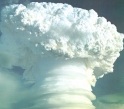 |

The Cold War was ended, in no small measure, by the commitment of the United States to fund an advanced strategic defense initiative. The technological competition rose to a level at which the Soviet Union could not compete. Even had MAD played a role in keeping the nuclear powers from dropping bombs on each other, there is no guarantee that this paradigm will function in the future.
 |
The genie is out of the bottle. Nuclear weapons have disappeared from Soviet-era stockpiles in many former-Soviet states. These warheads have almost certainly made their way to Middle Eastern countries. Some of the more radical Islamic fundamentalists have proven repeatedly their willingness to die as individuals to achieve their goals. If a group of radical militants is willing to commit suicide by carrying a bomb to its destination, or having one of their number do so, how much protection do you suppose other nations have in the concept of Mutual Assured Destruction? Why should fanatics care if retaliation is swift and deadly? After all, according to their fundamental religious precepts, they are guaranteed a place in paradise if they die in a holy war.
The problem is no longer limited to nuclear warfare, if indeed it ever was. We now have chemical and biological weapons of incredible toxicity. The subway gas attacks in Tokyo by the followers of the Aum Shinrikyo movement may be indicative of the near future. During the Persian Gulf War, various cities in Saudi Arabia and Israel were bombarded by Iraq with short range missiles. The year's since have provided ample opportunity for Iraq to acquire more sophisticated delivery systems and more effective payloads.
The proliferation of nuclear, chemical, and biological weapons is not entirely a negative situation. After all, these weapons are very hazardous. Improper handling of nuclear material has resulted in many deaths. It seems likely that those with newly acquired knowledge in developing countries may be somewhat more likely to experience accidents. These may be thought of as evolution in action, taking out those most likely to use such weapons for terrorist purposes.
We cannot, however, rely on such accidents for any significant level of assurance. Rather, we must expect that these weapons will be used. Most likely, they will be used by governments on indigenous or neighboring populations, though the possibility of a terror attack in the United States was brought home quite poignantly by the World Trade Center bombing.
A nuclear attack initiated by any party may well escalate out of control. It is widely accepted that Israel has nuclear weapons. If Iraq or any other nation delivers a nuclear warhead to target on an Israeli city, the response is likely to be immediate nuclear retaliation. If the warhead is delivered not by missile but by terrorist activity, there is still some possibility of nuclear retaliation. How the various nuclear powers of the world respond to a small scale nuclear war in the Middle East is certainly an interesting subject for analysis. The possibility of such a small scale conflagration escalating into global thermonuclear war seems very real.
Even an accident with a biological weapon of sufficient ferocity may have disastrous consequences. Chemical weapons are relatively innocuous in comparison, as they tend to be diluted by wind, water, and time. Many of the more exceptionally deadly chemical agents break down after prolonged exposure to sunlight. Biological weapons, though, may be able to propagate through a very wide territory, killing everyone within reach.
We now have weapons of such sophistication that the elimination of our planet's biosphere is a real near-term possibility. To protect against such an event, we should seek to make humanity a multi-planetary species.
Given the potential of cataclysms which could make Earth uninhabitable or severely under-inhabited, what course of action is most appropriate for advancing the settlement of space? Obviously, the most effective, most rapid, and most diverse approach to space settlement would be best. The free enterprise approach is precisely what we need.
Market forces foster diversity, allowing for multiple approaches to be developed simultaneously. Market forces quickly eliminate ineffective activities while encouraging the proliferation of effective actions. In contrast, the centrally planned approach tends to bog down in corruption, ineffectiveness, and the tremendous difficulties of predicting the future consequences of current actions.
Thus, the survival of humans as a species may well depend on our ability to unleash the forces of free enterprise on the opportunity of space achievement.
| Mushroom Cloud Depository |